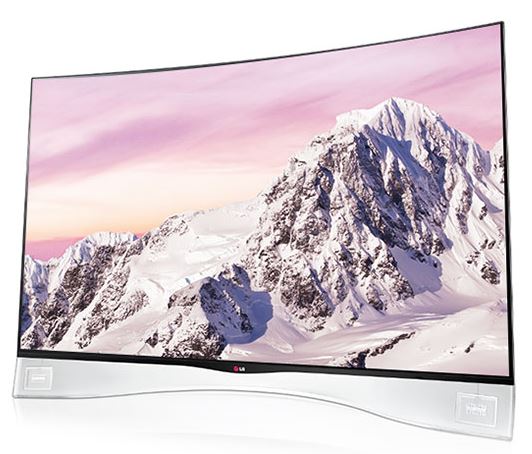OLED – LG Display will ramp up its M2 OLED-TV panel line next month, according to a report in South Korea’s ET News quoted in English on November 11 by Amy Fan and Alex Wolfgram in Digitimes.
As previously reported, the new $640 million line is expected to have a monthly capacity of 34,000 units, quadrupling the company’s current capacity. LGD will be producing 55″, 65″ and 77″ panels, at significantly higher yield – and therefore at lower cost – than has been possible in the past.
Digitimes Research reports that production concerns have caused LG Electronics to reduce its OLED-TV sales target for 2015 to 800,000 sets from 5 million. Digitimes Research expects OLED-TV prices to remain about double those Ultra-HD LCD-TVs through 2016, reported Fan and Wolfgram.

LG’s FHD 55″ EA9800 OLED-TV is curved, beautiful, and currently available for roughly $3000. (Photo: LG Electronics)
At Display Week this past June, Changho Oh, Senior VP for LG Display’s OLED TV Development Division 1, told me that the company’s Fab 1 was producing panels for LG’s 55″ OLED TV at a 70–80% yield. That was a remarkable improvement from what was widely estimated to be a 10% yield in the middle of 2013 and 50% early this year. Manufacturing yields for 55″, 65″ and 77″ panels will vary by size, Oh said. New-for-2014 OLED-TV models will all have curved screens.
The striking improvement in yield has been due to improvements in IGZO stability. Oh told me very openly that the oxide-TFT process has very narrow process margins and obtaining good yields was difficult in the development stage. It is necessary, he said, to understand all of the characteristics and to be able to control them precisely. The situation with the OLED frontplane, he said, “…is not so difficult because we use WOLED”, referring to the white OLED process LG uses for its TV panels. He confirmed that most of the yield issues were related to the oxide-TFT process and the “very complicated backplane”, which uses four transistors per pixel in LGD’s design. As a result, an extra power line must be designed into the backplane.
Farther down the line, LG might consider using a different oxide. For now, the company has made its investment and is enjoying the fruits of its labors.
Oh agreed that the blue OLED lifetime remains on the short side. LGD specifies that the D6500 white point cannot vary by more than 500°C over 20,000 hours, which represents about 7 years of viewing for the typical consumer. Oh said this is a tough spec, but LGD is meeting it.
Oh also said speculations that the oxygen/moisture barrier is a problem for TV-sized panels are not correct. LG uses a 0.1-mm metal sheet and tests the seal by bending the panel 20,000 times without difficulty.
Although LGD has improved manufacturing yields dramatically, it is widely believed that solution processing – applying the OLED materials in liquid form with one of a variety of printing-like processes – is the way to make OLED manufacturing costs competitive with those of LCDs. Oh confirmed that LG has a large research program in this area, and noted that equipment and development are expensive. LG’s goal is to have solution-based OLED panels available in 2018.
With Samsung having temporarily retreated to the sidelines as far as TV-sized OLED panels are concerned, development is in LGD’s hands. And LGD is committed to making the most of its lead. The company is making its OLED panels available to Chinese set-makers, so look for companies such as TCL and Hisense to lead the way with relatively low-cost OLED-TVs next year. – Ken Werner

